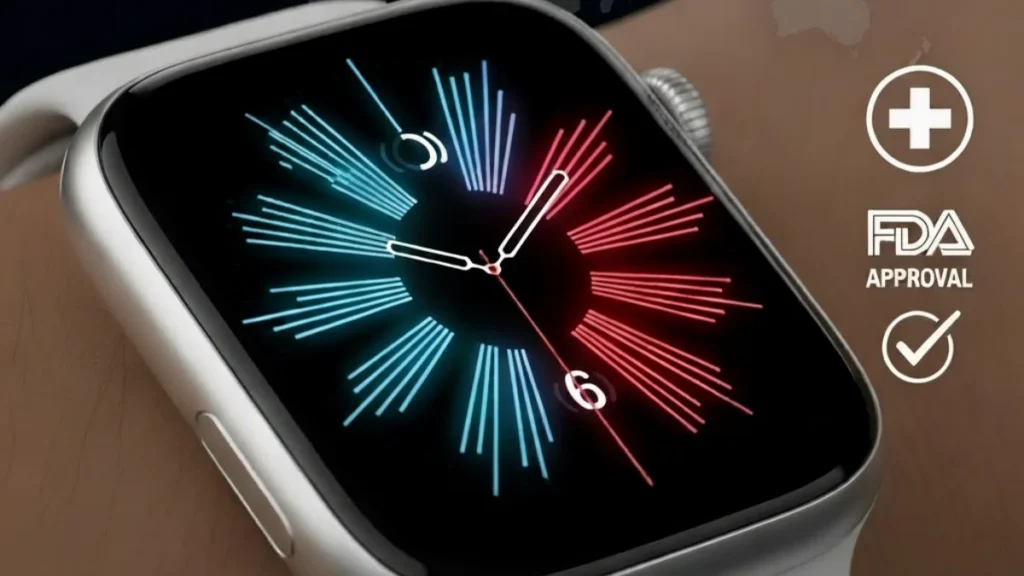Apple just added a heart-health upgrade to its best-selling wearable.
Starting Friday, the new Apple Watch Series 11 — and recent models like the Series 9 — will notify users if AI detects signs of high blood pressure. The feature, now FDA-cleared, could help millions uncover hidden hypertension before it leads to serious illness.
Key Takeaways
- Apple Watch AI tool can flag possible high blood pressure early.
- FDA approved the feature, though it’s not a direct measurement.
- Alerts encourage users to confirm results with traditional cuff devices.
- Rollout spans 150+ countries, targeting global hypertension awareness.
- Experts urge caution: no substitute for medical diagnosis.
Apple has introduced an FDA-approved AI feature for Apple Watch that notifies users of possible high blood pressure. The tool analyzes sensor data but does not measure blood pressure directly. Instead, it prompts users to confirm with a cuff device and consult a doctor, aiming to reduce undiagnosed hypertension worldwide.
Apple Uses AI to Detect Blood Pressure Risks
Apple is leaning on artificial intelligence to tackle one of the world’s most pervasive health problems: hypertension. Beginning with the Apple Watch Series 11, and rolling back to Series 9 models, the device can now send notifications when it detects patterns linked to high blood pressure.
The company trained machine-learning models on sensor data collected from more than 100,000 participants in its 2019 Heart and Movement Study. After refining the algorithm with a focused group of 2,000, Apple secured clearance from the U.S. Food and Drug Administration (FDA).
Why It Matters for Global Health
High blood pressure is a silent condition affecting more than one billion people worldwide. Roughly half of adults with hypertension remain undiagnosed, often because blood pressure checks happen only during medical visits.
Apple’s AI-driven approach won’t replace traditional devices, but it could nudge millions toward early detection. By issuing alerts, the watch encourages users to follow up with a cuff-based test and seek medical advice.
Expert Insights: Promise and Caution
Sumbul Ahmad Desai, Apple’s vice president of health, told Reuters that the feature is the product of years of research into identifying hypertension signals from existing sensors.
Dr. Ami Bhatt, chief innovation officer at the American College of Cardiology, called the rollout “a powerful awareness tool” but warned against over-reliance. “There is also the risk of false reassurance — those who don’t get an alert may wrongly assume they don’t have hypertension,” she noted.
Experts agree Apple has been cautious in designing the feature to minimize false positives that could cause unnecessary alarm. Still, both Apple and cardiologists stress the importance of confirming alerts with medical-grade devices.
Global Rollout
Apple plans to launch the feature in more than 150 countries. That global reach could have outsized impact, particularly in regions where hypertension screening is limited. By embedding the alert system into a popular consumer device, Apple may bring preventative awareness to populations who rarely undergo regular checkups.
The Bigger Picture: AI in Consumer Health
The development marks another step in Apple’s broader health strategy, where wearables act as preventive tools rather than diagnostic devices. The company has already introduced features such as irregular heart rhythm notifications and blood oxygen monitoring.
With hypertension, the stakes are especially high. Left unchecked, it can lead to heart attacks, strokes, and kidney disease. If Apple’s alerts encourage even a fraction of users to get tested earlier, the public health benefits could be significant.
Risks Ahead
The technology is not foolproof. Because the watch does not directly measure blood pressure, false negatives and false positives remain possible. Regulatory approval confirms safety and efficacy within certain limits, but experts caution against treating the notification as a replacement for traditional monitoring.
Everyday Consequences for Users
For everyday users, the feature could mean getting an early heads-up on a condition that often shows no symptoms. Imagine glancing at your wrist and seeing a prompt to check your blood pressure — that nudge could lead to a doctor’s visit that prevents a heart attack years later.
Conclusion
Apple’s AI-driven alerts won’t replace the cuff at your doctor’s office, but they could change how millions think about blood pressure. By embedding preventive nudges into a device worn daily, Apple is making hypertension awareness a part of everyday life.
